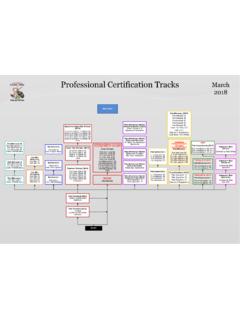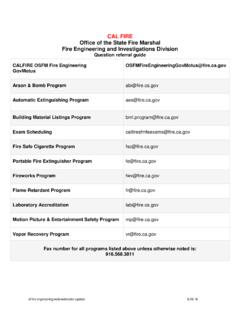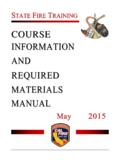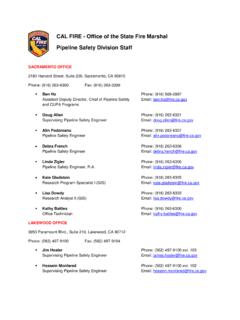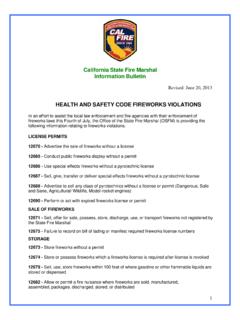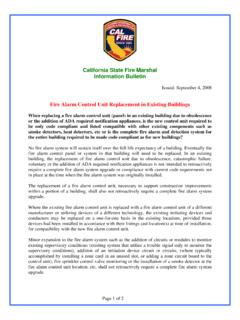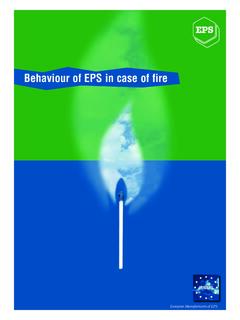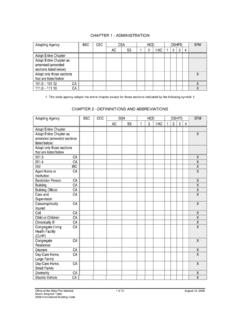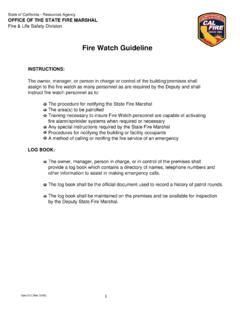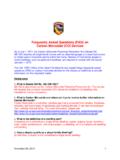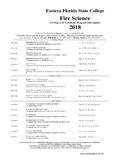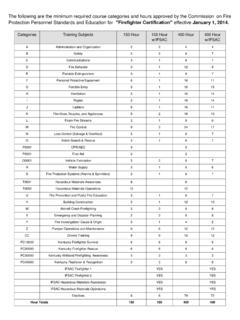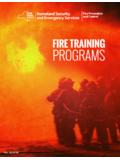Transcription of Confined-Space Rescue Awareness - osfm.fire.ca.gov
1 Confined-Space Rescue Awareness Confined-Space Rescue Awareness course Plan course Details Description: This course provides Awareness -level instruction in identifying a permit and nonpermit required confined space, the hazards associated with confined spaces, state regulations and industry standards, incident management, communications, and equipment requirements. This course does not qualify participants to make permit-required entries. Designed For: Emergency responders Authority: Cal-OSHA CCR Title 8 Article 108 5157. NFPA 1006 Standard for Technical Rescue Personnel Professional Qualifications (2017). NFPA 1670 Standard on Operations and Training for Technical Search and Rescue Incidents (2017).
2 Prerequisites: None Corequisites: None Standard: Complete all activities and formative tests. Complete all summative tests with a minimum score of 80%. Hours: Lecture: 6:05. Activities: 1:55. Hours (Total): 8:00. Maximum Class Size: 60. Instructor Level: Trained to the Confined-Space operations or technician level Instructor/Student Ratio: 1:60. Restrictions: None SFT Designation: FSTEP. March 2018 Page 1 of 19. Confined-Space Rescue Awareness Required Resources Instructor Resources To teach this course , instructors need: Cal-OSHA CCR Title 8 Article 108 5157. NFPA 1006 Standard for Technical Rescue Personnel Professional Qualifications (2017). NFPA 1670 Standard on Operations and Training for Technical Search and Rescue Incidents (2017).
3 Worker Deaths in Confined Spaces: A Summary of NIOSH Surveillance and Investigative Findings, Department of Health and Human Services, Public Health Service, Centers for Disease Control and Prevention, and National Institute for Occupational Safety and Health, 1994. The Confined Space Guide, California Department of Industrial Relations, 2012. Department of Transportation Emergency Response Guidebook (DOT ERG). Policies and procedures of the authority having jurisdiction To teach this course , instructors may choose to use: Confined Space Entry and Rescue Manual, 2013, CMC Rescue , Inc. Training for Hazardous Materials Response: Confined Space Rescue (IAFF). Manufacturers' videos, manuals, and directions for equipment use Online Instructor Resources The following instructor resources are available online at : Cal-OSHA CCR Title 8 Article 108 5157.
4 NFPA 1006 Standard for Technical Rescue Personnel Professional Qualifications (2017). NFPA 1670 Standard on Operations and Training for Technical Search and Rescue Incidents (2017). Worker Deaths in Confined Spaces: A Summary of NIOSH Surveillance and Investigative Findings, Department of Health and Human Services, Public Health Service, Centers for Disease Control and Prevention, and National Institute for Occupational Safety and Health, 1994. (PDF available at: ). Student Resources To participate in this course , students need: Any textbook(s) required by the instructor March 2018 Page 2 of 19. Confined-Space Rescue Awareness Facilities, Equipment, and Personnel The following facilities, equipment, or personnel are required to deliver this course : Equipment AV equipment March 2018 Page 3 of 19.
5 Confined-Space Rescue Awareness Unit 1: Introduction Topic 1-1: Orientation and Administration Terminal Learning Objective At the end of this topic, a student will be able to identify facility and classroom requirements and identify course objectives, events, requirements, assignments, activities, resources, evaluation methods, and participation requirements in the course syllabus. Enabling Learning Objectives 1. Identify facility requirements Restroom locations Food locations Smoking locations Emergency procedures 2. Identify classroom requirements Start and end times Breaks Electronic device policies Special needs and accommodations Other requirements as applicable 3. Review course syllabus course objectives Calendar of events course requirements Student evaluation process Assignments Activities Required student resources Class participation requirements Discussion Questions 1.
6 To be determined by the instructor Activities 1. To be determined by the instructor March 2018 Page 4 of 19. Confined-Space Rescue Awareness Unit 2: Overview of Confined Spaces Topic 2-1: Identifying Regulations and Standards Terminal Learning Objective At the end of this topic, given applicable regulations and standards, a student will be able to identify the regulations and industry standards relating to Confined-Space incidents. Enabling Learning Objectives 1. Describe the difference between a regulation or law and a standard Titles Codes Regulations Laws Acts Guidelines Standards 2. Identify the applicable industry regulations 3. Identify the applicable industry standards Discussion Questions 1.
7 Which are mandatory, laws or standards? Which are recommended? Activities 1. The instructor must create an activity directing students to differentiate between laws and standards. Instructor Resources 1. The instructor should refer to Cal-OSHA CCR Title 8 Article 108 5157, NFPA 1006. Standard for Technical Rescue Personnel Professional Qualifications (2017), and NFPA. 1670 Standard on Operations and Training for Technical Search and Rescue Incidents (2017), at minimum. Topic 2-2: Describing the History and Dangers of Confined-Space Incidents Terminal Learning Objective At the end of this topic, given reports and industry standards, a student will be able to describe the history behind the dangers of confined spaces and describe the industry- recognized levels of training.
8 Enabling Learning Objectives 1. Identify historical reports and dangers Worker Deaths in Confined Spaces o Most deaths were would-be rescuers . Current Confined-Space related death statistics 2. Recognize confined space Rescue training levels Awareness Operations (no longer offered in California). March 2018 Page 5 of 19. Confined-Space Rescue Awareness Technician Discussion Questions 1. Who was the most likely to get injured in the 1994 report? 2. What is the difference between the Awareness and technician levels of training? Activities 1. The instructor must present case studies. Instructor Notes 1. The instructor should refer to: Worker Deaths in Confined Spaces: A Summary of NIOSH.
9 Surveillance and Investigative Findings, Department of Health and Human Services, Public Health Service, Centers for Disease Control and Prevention, and National Institute for Occupational Safety and Health, 1994. 2. The instructor should refer to: The Confined Space Guide, California Department of Industrial Relations, 2012. Topic 2-3: Defining and Recognizing a Confined Space Terminal Learning Objective At the end of this topic, a student, given Cal-OSHA CCR Title 8 Article 108 5157, will be able to define and recognize a confined space. Enabling Learning Objectives 1. Recognize the space is large enough and so configured that an employee can bodily enter and perform assigned work 2.
10 Recognize the space has limited or restricted means for entry or exit; for example: Tanks Vessels Silos Storage Bins Hoppers Vaults Pits 3. Recognize the space is not designed for continuous employee occupancy Discussion Questions 1. What kinds of confined spaces might you encounter in your authority having jurisdiction (AHJ)? Activities 1. To be determined by the instructor Instructor Notes 1. Ensure that students can recognize a confined space. Topic 2-4: Defining and Recognizing a Permit-Required Confined Space Terminal Learning Objective At the end of this topic, a student, given Cal-OSHA CCR Title 8 Article 108 5157, March 2018 Page 6 of 19. Confined-Space Rescue Awareness will be able to define and recognize a permit-required confined space.
